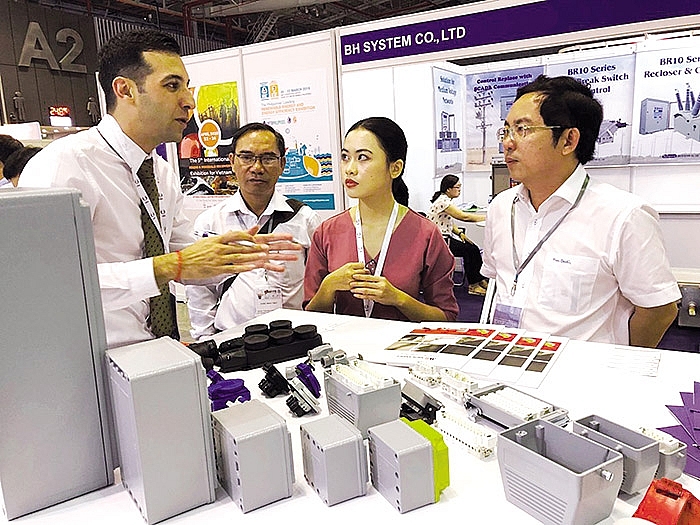Indian state visit pushes countries to 2020 target
 |
| With Vietnam becoming an attractive investment spot, many Indian companies have boosted investment in the country, photo: Le Toan |
Indian President Ram Nath Kovind will pay a state visit to Vietnam on November 18-20 during which time the two nations are expected to ink several partnership deals and a joint statement.
Representatives of about 80 Indian firms will join the visit. Operating across many sectors, including energy, agriculture, healthcare, services, IT, tourism, and education, they will meet with Vietnamese partners to discuss business and investment co-operation plans at a Vietnam-India business forum in Hanoi. About 200-250 Vietnamese businesses will attend.
It is expected that the leaders of the two countries will discuss specific proposals to boost bilateral co-operation in energy and a series of new sectors which will help reach their bilateral trade turnover target.
Vietnam and India have pledged to explore new trade and investment opportunities of identified priority, including hydrocarbons, power generation, renewable energy, energy conservation, infrastructure, textiles, footwear, pharmaceuticals, machine tools, agriculture and agro-products, tourism, chemicals, ICT, and other services.
According to a joint statement released in March, Vietnam expressed its welcome for Indian renewable energy and energy conservation projects in the country. It also welcomes Indian businesses to expand their oil and gas exploration and exploitation activities on Vietnamese land and continental shelf, as well as exclusive economic zone, and to this effect suggested that Indian companies file concrete proposals for the blocks offered by the Vietnamese side.
“Both sides agreed to actively pursue the signing of a Memorandum of Understanding on collaboration in oil and gas exploration projects in third countries. The Vietnamese side also welcomed Indian oil and gas companies to seize opportunities in the midstream and downstream sectors in Vietnam,” read the statement.
Vietnam has also taken note of India’s request to actively consider signing the Framework Agreement of the International Solar Alliance with a view to strengthening co-operation in renewable energy.
Indian Ambassador to Vietnam, Parvathaneni Harish, recently told VIR how co-operation in oil, gas, and renewable energy are an important focus for the ties between India and Vietnam in the near future. “Many Indian businesses operating in the solar and wind energy industries are looking for investment opportunities in Vietnamese provinces,” he said.
Indian energy developers, such as Tata Group, Adani Green Energy Ltd., and Suzlon Energy Ltd., are dreaming of big green energy projects in Vietnam thanks to the country’s favourable renewable energy development policies. Tata Group is now constructing the $1.8 billion Long Phu 2 thermal power plant in the southern province of Soc Trang, which is scheduled to be completed by 2022.
According to Vietnam’s Ministry of Planning and Investment, as of October 20, India had 201 valid investment projects in Vietnam registered at $876.7 million.
Currently, further tariff cuts under the ASEAN-India Trade in Goods Agreement – part of the ASEAN-India Free Trade Agreement (AIFTA) – are expected to be a key driver of a surge in Vietnamese-Indian trade turnover and a rise in Indian investment in Vietnam in the near future.
According to statistics from Vietnam’s General Statistics Office (GSO), in the first nine months of 2018, the total trade turnover between Vietnam and India hit $8.27 billion, up from $5.62 billion on-year, with Vietnam earning $5.17 billion from exporting goods to India, and spending $3.1 billion on Indian goods.
Last year, the total bilateral trade turnover reached $7.62 billion, with Vietnam earning $3.75 billion from selling goods to India and spending $3.87 billion on importing Indian goods.
The rise in trade largely came from tariff cuts under the AIFTA. Under the Vietnamese government’s Decree No.159/2017/ND-CP on Vietnam’s special import tariff scheme to implement the AIFTA for the 2018-2022 period, 5,668 lines of tariffs, accounting for 59 per cent of the scheme, will be either removed or reduced.
Tariffs on over 4,000 product lines were eliminated last year. The last period for tariff reduction or complete elimination under the various categories for the country is set for 2024.
What the stars mean:
★ Poor ★ ★ Promising ★★★ Good ★★★★ Very good ★★★★★ Exceptional
 Tag:
Tag:
Related Contents
Latest News
More News
- Ho Chi Minh City hits $8.37 billion in FDI (December 29, 2025 | 08:28)
- Tax sector wraps up 2025 and sets priorities for next year (December 25, 2025 | 14:00)
- Heavy industries set for pilot greenhouse gas quotas (December 25, 2025 | 10:00)
- $250 million deal targets women-owned SMEs, sustainable agriculture (December 22, 2025 | 17:40)
- UOB sees Vietnam growth easing in fourth quarter (December 22, 2025 | 17:39)
- Government moves to establish International Financial Centre (December 21, 2025 | 21:00)
- Vietnam's IFC to target global investment flows (December 21, 2025 | 18:00)
- Ha Tinh breaks ground on major Vingroup industrial and energy projects (December 19, 2025 | 18:24)
- EVN launches major power infrastructure projects nationwide (December 19, 2025 | 18:17)
- VAL inaugurates second production line to meet domestic animal feed demand (December 19, 2025 | 16:37)























 Mobile Version
Mobile Version